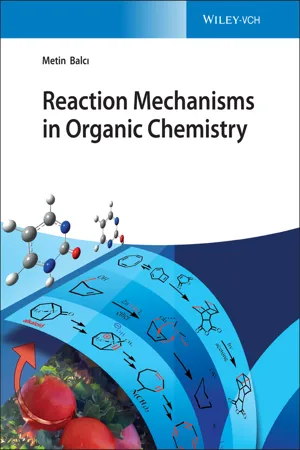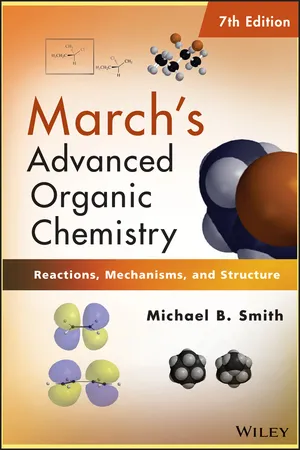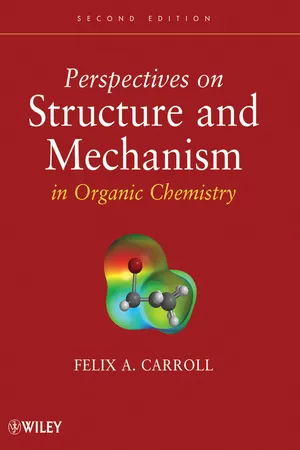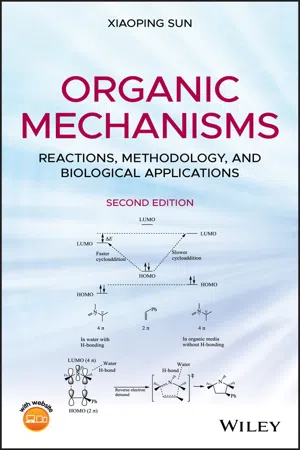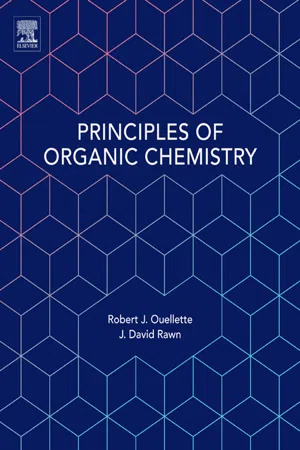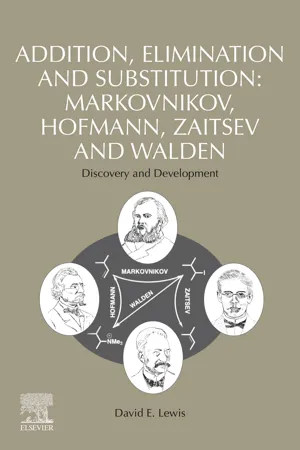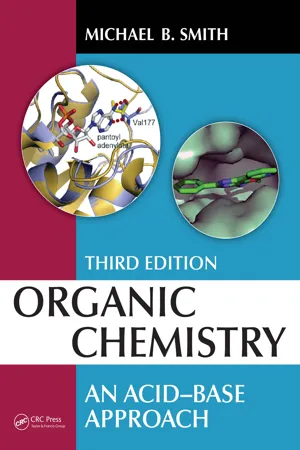Chemistry
E2 Elimination
E2 elimination is a chemical reaction in which a leaving group is expelled from a molecule, resulting in the formation of a double bond. This process occurs in a single step and requires a strong base to abstract a proton from the molecule. E2 elimination is commonly observed in organic chemistry reactions, particularly in the synthesis of alkenes.
Written by Perlego with AI-assistance
Related key terms
Related key terms
1 of 4
Related key terms
1 of 3
7 Key excerpts on "E2 Elimination"
- eBook - ePub
- Metin Balc?, Metin Balc?, Metin Balc?, Metin Balc?, Metin Balc?(Authors)
- 2021(Publication Date)
- Wiley-VCH(Publisher)
N 2 reaction, the E2 reaction also proceeds in one step with one transition state and without the formation of any intermediates. The bond-breaking and bond forming that occur during E2 reactions are shown by the curved arrows.In a bimolecular elimination reaction, the abstraction of a proton from a carbon atom next to the carbon bearing the leaving group, cleavage of the C—X bond, and the formation of a double bond occur in a concerted manner in a single step. The E2 Eliminations are observed in systems that cannot produce stable carbocations. Primary alkyl compounds are transformed into alkenes via E2 mechanism. There are remarkable similarities between E2 and SN 2 reactions, as between E1 and SN 1 reactions. Because the first attack comes from the base in E2 reactions, it is essential to have a strong base to abstract the proton. While the base abstracts the proton, the bonding electrons that it shared with carbon move toward the adjacent carbon atom bearing the leaving group. The electrons attack the carbon atom from the back as a nucleophile and depart the leaving group. When the reaction is completed, the electrons that were originally bonded to the hydrogen atom form the π bond.Like the SN 2 reaction, an E2 reaction requires a precise geometry. According to the mechanism given above, the four reacting atoms, i.e. the hydrogen to be eliminated, two carbon atoms to which the hydrogen and the leaving group are bonded, and the leaving group, must lie in a plane. There are two conformations in which the C—H bond and the C—X bond can be in the same plane. In an arrangement like that, the orbitals align appropriately for the formation of a π bond. The proton and the leaving group can be in either an anti-periplanar or syn-periplanar conformation. If the elimination proceeds from the anti-periplanar conformation, it is called anti- or trans-elimination. If it proceeds from the syn-periplanar conformation, it is called cis- or syn-elimination. Of these possible two conformations, the anti-periplanar conformation is the more commonly encountered in E2 reactions. In the transition state, the base is far away from the leaving group. The transition state for syn-periplanar elimination has higher energy resulting from the eclipsed interaction between the substituents. Furthermore, the base must approach close to the leaving group, and there will be strong repulsion between the leaving group and the base. However, some cyclic compounds have rigid geometry. Such compounds can undergo an E2 Elimination reaction by a concerted syn-periplanar mechanism. In acyclic systems, because the carbon–carbon bonds rotate freely, the molecule can always adapt the necessary conformation. However, it is not still possible to have an ideal trans - No longer available |Learn more
March's Advanced Organic Chemistry
Reactions, Mechanisms, and Structure
- Michael B. Smith(Author)
- 2013(Publication Date)
- Wiley(Publisher)
517.A.i. The E2 Mechanism
In the E2 mechanism (elimination, bimolecular), the proton on the β carbon is pulled off by a base, leading to near-simultaneous expulsion of the leaving group (nucleofuge):The mechanism takes place in one step and is kinetically second order: first order in substrate and first order in base. An ab initio study has produced a model for the E2 transition state geometry.6 The IUPAC designation is AxH DH DN , or more generally (to include cases where the electrofuge is not hydrogen), An DE DN . It often competes with the SN 2 mechanism (Sec. 10.A.i). With respect to the substrate, the difference between the two pathways is whether the species with the unshared pair attacks the carbon (and thus acts as a nucleophile) or the hydrogen (and thus acts as a base). As in the case of the SN 2 mechanism, the leaving group may be positive or neutral and the base may be negatively charged or neutral.Evidence for the existence of the E2 mechanism includes (1) the reaction displays the proper second-order kinetics; (2) when the hydrogen is replaced by deuterium in second-order eliminations, there is an isotope effect of from 3 to 8, consistent with breaking of this bond in the rate-determining step.7 However, neither of these results alone could prove an E2 mechanism, since both are compatible with other mechanisms also (e.g., see E1cB, Sec. 17.A.iii). The most compelling evidence for the E2 mechanism is found in stereochemical studies.8 - No longer available |Learn more
- Felix A. Carroll(Author)
- 2011(Publication Date)
- Wiley(Publisher)
CHAPTER 10 Elimination Reactions 10.1 INTRODUCTIONIn an elimination reaction, a substrate loses two substituents, with a resulting increase in its number of units of unsaturation.1 The familiar E1 and E2 reactions of alkyl halides provide some of the fundamental conceptual models for understanding and categorizing the reactions of organic compounds. As with substitution and addition reactions, however, simple mechanistic labels serve only as beginning points for the discussion of a wide range of elimination pathways.The most familiar elimination reactions are 1,2-eliminations, which are commonly known as β -eliminations and which are termed 1 /2-eliminations in the IUPAC system.1 In such reactions, a leaving group departs from one (α ) atom, while a proton or other group leaves from the adjacent (β ) atom (Figure 10.1 ).2 Many fundamental aspects of 1,2-elimination reactions were developed through the work of Hughes, Ingold, and their co-workers and were reported in 1948.3, 4 The common mechanistic designations E1 (elimination unimolecular) and E2 (elimination bimolecular) were also suggested by Ingold.5As with addition reactions, an important stereochemical distinction in elimination reactions is that of syn and anti pathways. These pathways were sometimes referred to in older terminology as “trans” or “cis” eliminations. As was noted in Chapter 9, current preference uses the terms syn and anti for mechanisms and reserves the terms cis and trans for structures. When applied to an elimination reaction, the term anti means that one group detaches from the top of the molecule (as defined by the developing bond) while the other group detaches from the bottom. In syn elimination, both groups detach from the same face. As shown in Figure 10.2 - eBook - ePub
Organic Mechanisms
Reactions, Methodology, and Biological Applications
- Xiaoping Sun(Author)
- 2020(Publication Date)
- Wiley(Publisher)
Symmetry analysis and theoretical studies using the MO model for the α‐elimination are presented in the chapter. The mechanism for the related rearrangement of carbenes to alkenes via a C─H bond elimination will be discussed.Electronegative group facilitated E1cb reactions also possess important synthetic utility and mechanistic significance. They will be presented as well. Elimination reactions have found many applications in biological systems. In this chapter, mechanisms for a few selected enzyme‐catalyzed biological eliminations are reviewed.7.1 E2 Elimination: BIMOLECULAR β‐ELIMINATION OF H/LG AND ITS REGIOCHEMISTRY AND STEREOCHEMISTRY
7.1.1 Mechanism and Regiochemistry
The E2 reaction is a concerted, bimolecular β‐elimination of a functionalized alkane (R–LG, commonly, LG = Cl, Br, I, MsO, TsO, and TfO) induced by a strong base (B:− ). Usually, the reaction requires a staggered conformation in the functionalized alkane substrate, namely that the departing LG group and the β‐hydrogen to be cleaved should be anti‐coplanar (Fig. 7.1 ) in order for the reaction to be the most kinetically favorable [1 –4 ]. This stereochemistry feature for the reaction is called anti‐elimination. Figure 7.1 shows the general mechanism for the strong‐base induced E2 reaction of a functionalized alkane. In the staggered conformation (reactive conformer), the β‐hydrogen which is anti‐coplanar to a functional group is activated by the LG group and becomes slightly acidic. Under certain conditions, the acidic β‐hydrogen can be effectively attacked by a strong base (B:− ) along the direction of the H─Cβ bond to initiate a bimolecular elimination via a single transition state. In the transition state, the H─Cβ and C─LG bonds are being partially broken, coincident with the partial formation of a C=C π bond. As the transition state collapses, the alkene product is formed, together with the formation of the BH molecule and the LG− ion. Clearly, the stereochemistry of the reaction is determined by the structure of the transition state which correlates to the staggered conformation of the substrate. The relative orientations of all the groups attached to the Cα and Cβ (a, b, c, and d) are retained during the reaction. The reaction follows a second‐order rate law (Eq. 7.3 ) with first order in the base (B− - eBook - ePub
- Robert J. Ouellette, J. David Rawn(Authors)
- 2015(Publication Date)
- Elsevier(Publisher)
N 2 reaction mechanism, the E2 mechanism is a concerted process. In an E2 dehydrohalogenation reaction, the base (nucleophile) removes a proton on the carbon atom adjacent to the carbon atom containing the leaving group. As the proton is removed, the leaving group departs and a double bond forms.Like the SN 2 reaction, an E2 reaction requires a precise molecular arrangement. The anticonformation of the hydrogen and halogen atoms is preferred for the reaction because it aligns the orbitals properly for the formation of the π bond. We can visualize the process as the removal of the proton to provide an electron pair that attacks the neighboring carbon atom from the back to displace the leaving group. An E2 reaction occurs at a rate that depends on the concentrations of both the substrate and the base. If the substrate concentration is doubled, the reaction rate also doubles, as in SN 2 processes. Thus, both E2 and SN 2 mechanisms are affected in the same way, and the two mechanisms compete with each other.The E1 Mechanism
We recall that an SN 1 reaction proceeds in two steps, and that the rate-determining step is formation of a carbocation intermediate. Similarly, an E1 mechanism occurs in two steps, and the rate-determining step is the formation of a carbocation. Thus, just as E2 and SN 2 mechanisms compete with each other, an E1 mechanism competes with an SN 1 mechanism. Because the rate-determining step of an E1 reaction involves only the substrate, the formation of the carbocation is a unimolecular reaction. If the carbocation reacts with a nucleophile at the positively charged carbon atom, the result is substitution. But if the nucleophile acts as a base and removes a proton from the carbon atom adjacent to the cationic center, the net result in the loss of HL and the formation of a π bond—that is, an elimination reaction.7.7 Effect of Structure on Competing Reactions
Let’s now examine the variety of product mixtures that result from competing substitution and elimination processes. We will divide our discussion according to the type of haloalkane. These results are summarized in Table 7.2 - eBook - ePub
Addition, Elimination and Substitution: Markovnikov, Hofmann, Zaitsev and Walden
Discovery and Development
- David E. Lewis(Author)
- 2022(Publication Date)
- Elsevier(Publisher)
Journal of the Chemical Society between 1933 and 1964. In the course of these studies, they identified a number of the critical factors affecting the reaction, including the leaving group, the structure of the alkyl group, and the effect of solvent. The eliminations studied by Hughes and Ingold are readily separated into two classes, based on the reaction kinetics and molecularity.E2 Elimination
The first proposal of the bimolecular mechanism was for the Hofmann elimination by pyrolysis of quaternary ammonium hydroxides.108 –114The study of this reaction and the related eliminations of trialkylsulfonium ions,115 –123alkyl bromides,115 –119along with the “anomalous” hydrolysis reaction that frequently accompanied both provided much of the basis for the early mechanistic work of Hughes and Ingold. During these studies, the stereochemistry and mechanism of the E2 reaction were probed.124,125One of these studies,125the E2 Eliminations from menthyl chloride (216) and neomenthyl chloride (219), has found its way into organic chemistry textbooks at both the graduate and undergraduate levels. The E2 Elimination of menthyl chloride, which can only eliminate with anti stereochemistry by attaining the high-energy conformation 217, where the leaving group and a single β-hydrogen are both axial, gave 2-menthene (218) as the only product of a slow reaction; the E2 Elimination of neomenthyl chloride, where there are two β-hydrogen atoms anti to the leaving group in the low-energy conformation, gave mainly the Zaitsev regioisomer, 3-menthene (220), and proceeds some 200 times faster (Scheme 7.6 ). These experiments provided clear evidence that E2 Elimination must occur with anti stereochemistry.The reason for the differing regiochemistry of Zaitsev and Hofmann eliminations is traced to the different leaving groups. In the Zaitsev elimination, the leaving group departs as the conjugate base of a strong Lowry–Brønsted acid: Cl– (HCl), Br– (HBr), I– (HI), OTs– (TsOH), OMs– (MsOH), H2 O (H3 O+ ), etc. These are usually described as good leaving groups. In contrast to this, the leaving group in Hofmann eliminations departs as a weak base itself or the conjugate base of a weak acid: R3 N (R3 NH+ ), R2 S (R2 SH+ ), F– (HF), RCO2 – (RCO2 - eBook - ePub
Organic Chemistry
An Acid-Base Approach
- Michael B. Smith(Author)
- 2022(Publication Date)
- CRC Press(Publisher)
regioselective since one alkene is formed as the major product of two or more possible alkene products.3-Bromo-3-methylpentane has two β hydrogen atoms (Ha and Hb ), so there are two possible products, 3-methylpent-2-ene and 2-ethylbut-1-ene. The carbon bearing Ha has fewer carbon substituents and therefore Ha is a slightly stronger acid than Hb . The carbon bearing Hb has more carbon substituents therefore Hb is a weaker acid. If Ha were removed faster in the acid-base reaction, then 2-ethylbut-1-ene should be the major product, but it is not. The E2 reaction of 3-bromo-3-methylpentane gives 3-methylpent-2-ene as the major product by removal of Hb . Acidity of the β hydrogen atom in the starting material cannot be the most important factor for generation of the major product in an E2 reaction. Another factor must drive the reaction.- 12.2 Draw the elimination product expected when 2-bromo-3,3-dimethylbutane is treated with hydroxide ion and heated.
Removal of each different β-hydrogen leads to a different transition state in the reaction of 3-bromo-3-methylpentane and sodium ethoxide. Transition state 1 leads to 3-methylpent-2-ene, and 2 leads to 2-ethylbut-1-ene, as shown in Figure 12.3 . Removal of the more acidic hydrogen leads to transition state 2. Energetically, 2 is more like the starting materials since removal of the more acidic proton is faster. Formation of the more substituted and more stable alkene proceeds by transition state 1. Energetically, 1 is more like the isolated product, which is the more substituted alkene. The Hammond postulate states, “the transition state for a given step resembles the side of the reaction to which it is closer in energy.”2 In this reaction, 1 is a late transition state (more like the product) and 2 is an early transition state (more like the starting materials). Transition state 1 leads to the major product, consistent with a late transition state for E2 reactions. An E2 reaction always gives the more stable alkene .
Index pages curate the most relevant extracts from our library of academic textbooks. They’ve been created using an in-house natural language model (NLM), each adding context and meaning to key research topics.
Explore more topic indexes
Explore more topic indexes
1 of 6
Explore more topic indexes
1 of 4
